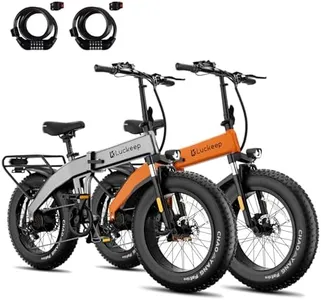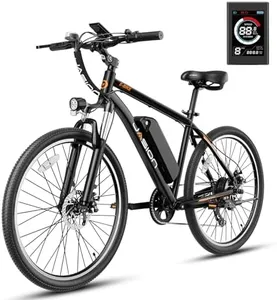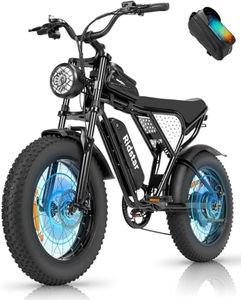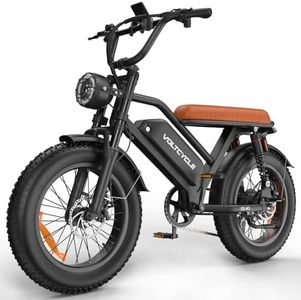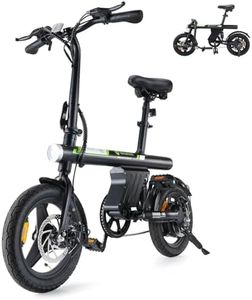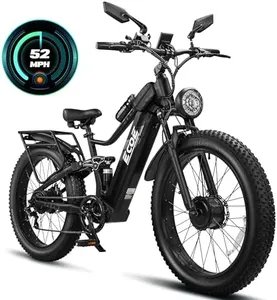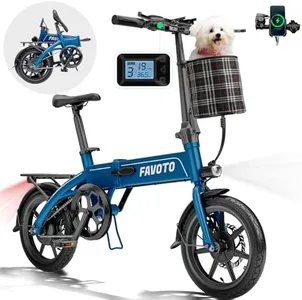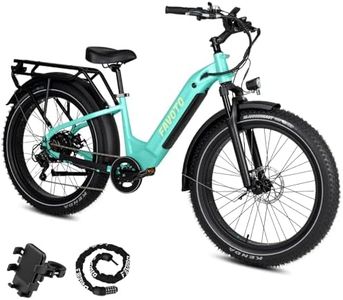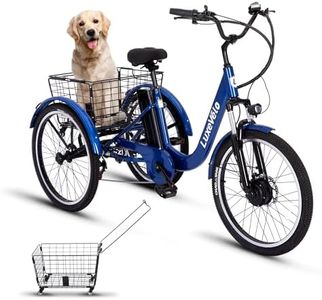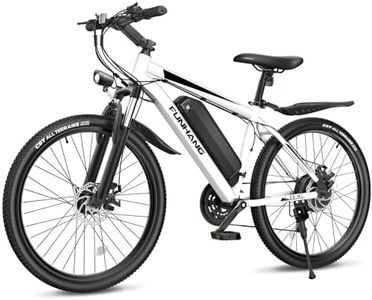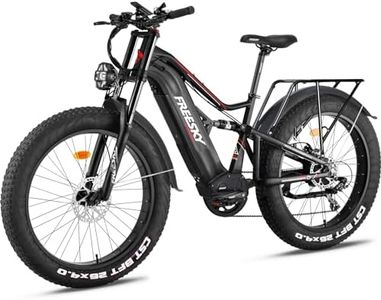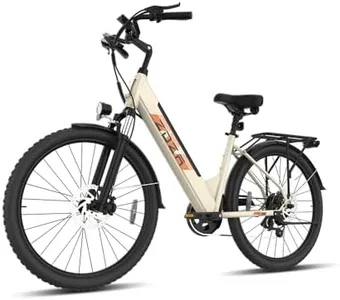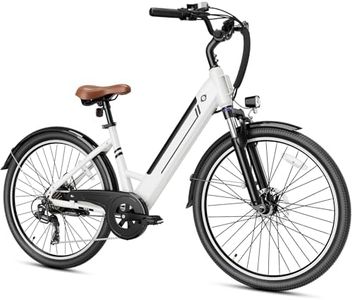10 Best Electric Bikes 2025 in the United States
Our technology thoroughly searches through the online shopping world, reviewing hundreds of sites. We then process and analyze this information, updating in real-time to bring you the latest top-rated products. This way, you always get the best and most current options available.

Our Top Picks
Winner
Jasion EB5 Electric Bike for Adults with Peak 500W Brushless Motor, 40Miles 20MPH Commuting Electric Mountain Bike with 360Wh Removable Battery, 7-Speed, 26" Tires and Front Fork Suspension
Most important from
1844 reviews
The Jasion EB5 Electric Bike is designed for adults, featuring a powerful peak 500W motor that allows speeds up to 20 MPH, making it suitable for commuting and light off-road use. The bike is equipped with a 360Wh removable battery that offers a range of 25-40 miles per charge, which is convenient for daily travel.
The 26-inch tires and front fork suspension provide a smooth ride, even on uneven terrains. Additionally, the 7-speed gears, dual mechanical disc brakes, and various riding modes, including pedal-assist and pure electric, offer versatility and control. The LCD display keeps you informed with essential riding data, and the bike's weight of 49.6 lbs is manageable for most users.
However, the frame is made of carbon steel, which, while stable, can be heavier compared to aluminum frames. Assembly is required, which might be challenging for some users. The bike supports a maximum weight of 264 pounds, making it accessible to a broad range of riders. With a minimalist design and practical features like a horn, kickstand, and front light, the Jasion EB5 is a solid choice for those seeking a reliable and comfortable electric bike for daily use.
Most important from
1844 reviews
Electric Bike for Adults Q20, 2000/1500W, 37/30MPH,52V 40AH,48V/20AH E-Bike,30-180 Miles Electric Motorcycle, 20" Fat Tire Dirt Bike, UL2849 All Terrain for Mountains, Snow, Sand, Road
The Ridstar Electric Bike for Adults Q20 features a strong and versatile 1500W brushless hub motor that allows for speeds up to 30 mph, making it suitable for urban commuting and adventurous rides on various terrains. Its peak motor power and effective climbing ability, up to a 40-degree gradient, are impressive for tackling challenging routes. The bike includes a substantial 52V 40AH battery, offering a notable range of up to 70 miles in pedal-assist mode, and charges relatively quickly within 4-6 hours.
The detachable battery and IP54 waterproof rating add to its practicality and durability in different weather conditions. The bike is equipped with 20-inch fat tires, ideal for stability across all terrains such as mountains, snow, sand, and roads, combined with a full suspension system for a smoother ride. Dual disc brakes and hydraulic dual brakes enhance safety by reducing braking distances significantly, particularly in wet conditions. The aluminum frame provides durability and supports a maximum weight of 330 pounds, though the bike itself is quite heavy at 66 pounds, which might be a drawback for some users.
It offers three customizable riding modes to suit various needs, whether for pure electric travel, assisted pedaling, or regular biking, along with convenient features like a phone holder and storage box. However, assembly is required, and some users might find this challenging despite the clear instructional videos provided. The Ridstar brand promises high quality and reliable customer support, making this bike a good fit for adults looking for a versatile, powerful, and feature-rich electric bike for both commuting and recreational purposes.
Electric Bike for Adults, 48V 18.2AH Electric Motorcycle, Long Seat Electric Bicycle Full Suspension 20" Fat Tire Ebike Max 28MPH& 30-60 Miles All Terrain E-Bike for Mountains, Snow, Sand, Road
Most important from
11 reviews
The VoltCycle Electric Bike for Adults is a solid choice for those seeking power and versatility in their rides. With a powerful 1000W brushless motor, it can reach speeds up to 28MPH, making it suitable for various terrains including mountains, snow, sand, and roads. The 48V 18.4Ah lithium-ion battery ensures a decent range of 50-60 miles in pedal-assist mode or up to 30 miles in full electric mode, though actual range may vary with terrain and rider conditions. The battery is also removable for convenient charging, which is a practical feature for daily use.
Its 20-inch fat tires provide stability and grip, particularly on rough or slippery surfaces, while the full suspension (dual front and rear) ensures a smoother ride over bumps and uneven terrain. Weighing 81lbs, it is relatively heavy, which could be a drawback for those needing to carry it over obstacles or up stairs. The bike frame is made of durable aluminum, supporting a maximum load of 330lbs, with a comfortable long seat that can accommodate two riders, making it great for family or partner rides.
The 7-speed gear system and customizable riding modes offer flexibility for various riding conditions, whether you prefer pure electric or pedal-assisted biking. Additional features like the digital LCD display, high-brightness front light, rear reflector, and dual shock absorbers enhance safety and usability. However, the bike's weight might be a concern for some users, and the 7-8 hour charging time could be lengthy compared to other models. It's a good option for those who need a robust and versatile electric bike for diverse environments, but potential buyers should consider the weight and charging time in their decision.
Most important from
11 reviews
Buying Guide for the Best Electric Bikes
Choosing the right electric bike (e-bike) can significantly enhance your commuting, leisure, or fitness experience. E-bikes come in various styles and with different features, so it's important to understand what to look for to find the best fit for your needs. Consider where and how you plan to use the e-bike, as well as your personal preferences and physical condition. Here are some key specifications to help you make an informed decision.FAQ
Most Popular Categories Right Now
